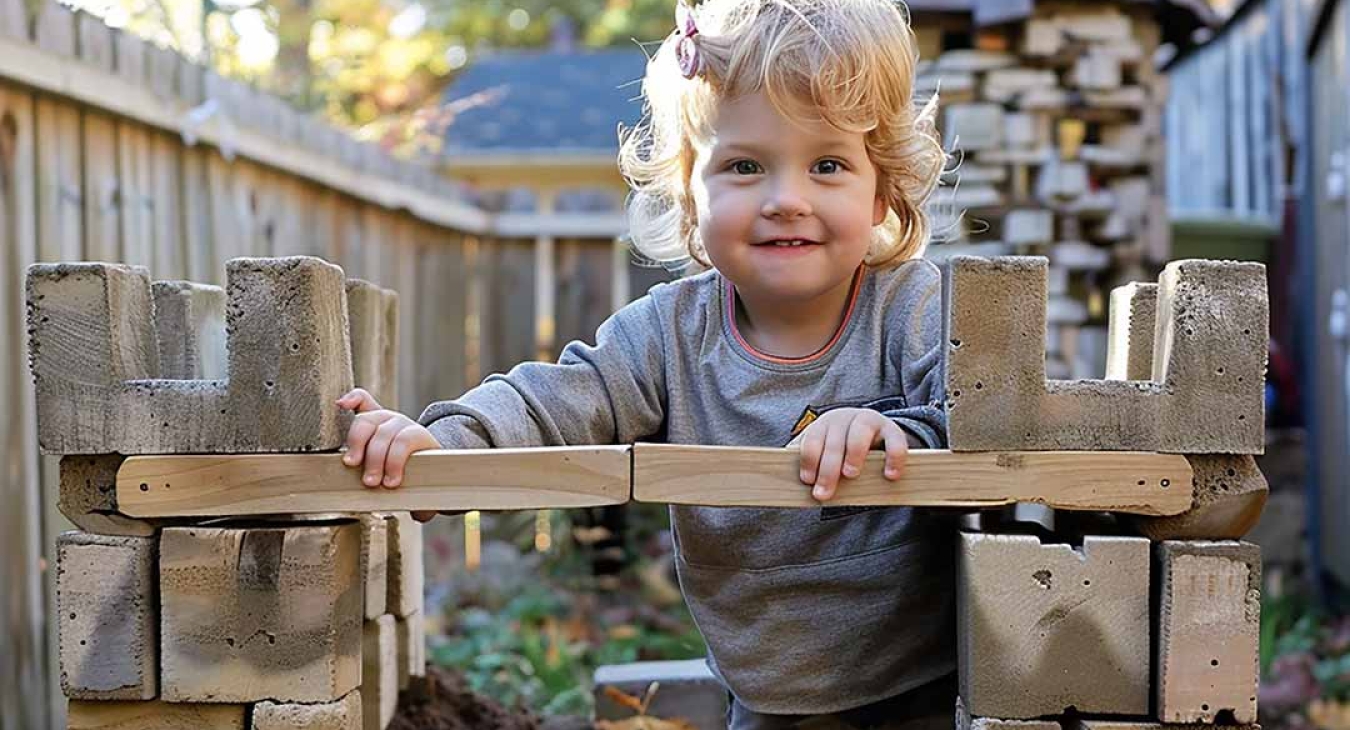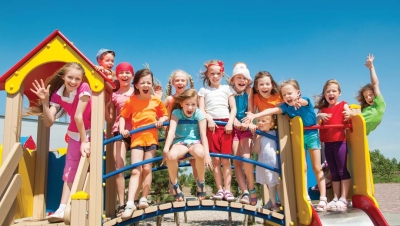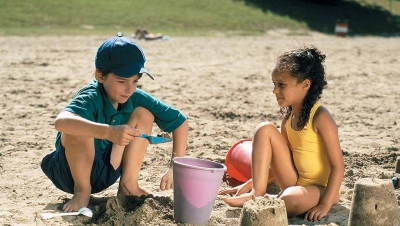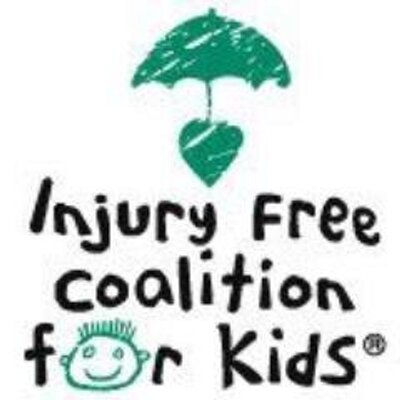The art of creative play and work
On July 1, 2008, the Texas Education Agency released the results of a groundbreaking physical fitness assessment of 2.6 million Texas public school students in grades 2-12, using six Cooper Institute FitnessGram tests. Only 32 percent of 3rd grade girls and 28 percent of boys achieved the “Healthy Fitness Zone" but by 12th grade, only eight percent of girls and nine percent of boys met the fitness standards. An obesity level of 19.1 percent for ages 10-17 placed Texas sixth among all states in 2007, and obesity increased and fitness declined during each recent year. Such a wake-up call resulted in annual legislative action in Texas since 2001, including a bill in 2007 requiring minimum levels of physical education and recess in public schools. Texas businesses spent about $3.3 billion in 2005 on obesity-related costs. No public funds were used in this assessment.
The children in one private Texas school, not victimized by reduction of physical education, deletion of recess, adult paranoia about lawsuits and injury, and high stakes testing, demonstrate how physical activity can contribute to fitness.
In 1974, the playground at Redeemer Lutheran School in Austin, Texas, was a decades-old collection of steel structures, typical of that period—see-saws, slides, horizontal ladders, swings, and open-base merry-go-round. The playground was void of plants and trees and the ground was scraped bare and packed hard by daily contact with playing bodies of children. These relics were removed in 1975 and replaced with materials built from scrap and cast-off materials by children, teachers, parents, and University of Texas graduate students. The resulting playground was intended to resemble in appearance and function the adventure playgrounds in Scandinavia and the UK, and serve as a research site for professors and graduate students.
In 1976, the first sponsor, Creative Playgrounds Corporation, added an obstacle course and in 1977, Educational Systems Inc., added a wood superstructure. The sites were expanded to broaden the base of play and environment studies across the three areas of the playground. Results of this and earlier research were reported in doctoral dissertations, professional articles, and books. With each passing year, the range of play options, research topics, and methods expanded to reflect interests of researchers and conclusions of earlier studies. Each study was approved by the University of Texas human subjects committees and by Redeemer School.
Beginning in 1974, two additional playgrounds were added to accommodate a wider range of developmental levels—preschool, primary, and elementary children. Between 1974 and 2000, corporations sponsoring or providing equipment for the playgrounds included Kidstruction, Grounds for Play, Kompan, Big-Toys, LittleTikes, and the present sponsor since 2000—GameTime, a PlayCore Corporation. In return for their contributions, research reports were provided to the major sponsor(s). The sites included both natural and built features intended to accommodate a wide range of play, development, and learning—spaces for organized games, spaces and materials for nature play and gardens, natural materials such as sand and water, wheel vehicle tracks, small animals, loose parts for construction, trees and shrubbery for shade and aesthetic qualities, fixed structures for active physical play, storage for tools and play props, and provisions for children with disabilities.
Over the years, Redeemer’s outdoor play and learning environments became an increasingly complex ecosystem of interrelated components—built playgrounds and natural habitats and gardens—connected to a curriculum of broad goals for hands-on learning and development. The developmental and learning benefits of playgrounds and natural habitats are complementary, each contributing to the goals of the program. The “butterfly garden” was recognized by the National Wildlife Federation as a certified school-yard habitat.
The playgrounds are bordered by vegetable and flower gardens, greenhouses, small animal habitats, and spaces for collecting, organizing, preparing for planting, and harvesting. A very special place, named by a child, The “Land Down Under,” is a half-acre water run-off pond, transformed into wilderness and wetlands. This space is extremely popular with children for building forts, exploring among the tall grasses, rolling down hillsides among flowers, and catching tadpoles in a small stream.
A jackrabbit selected the Land Down Under as his home and took occasional trips to the playgrounds where he was admired and protected by the children. Ducks, birds, butterflies, insects, and occasional larger borrowed animals have their homes on the premises. An adjacent classroom, equipped with microscopes, photographic equipment, and computers, allows children to explore the miniature features of both plants and animals in great detail.
As children grew in their knowledge of plants and animals with the guidance of a teacher/gardener/naturalist (Danna Keyburn), they began to take on work roles—maintaining the grounds with hand tools, preparing ground and plants for planting, cleaning up overgrown spaces and harvesting vegetables. The school cafeteria substitutes organic food for processed food and serves vegetables grown in the schoolyards. Children donate herbs grown in the gardens to Meals-On-Wheels. Physical activity (play and work) contributes to fitness and learning, with an obesity level of less than five percent for the school, in a state that ranks sixth for child obesity.
The children enrolled at Redeemer are from predominantly middle-income homes—Anglo, Asian, Hispanic and Afro-American. They participate in daily recess and physical education, complementing the nature “work” and helping maintain fitness and health while contributing to academic achievement. The principal reported that achievement test results are among the highest in the nation. The playground equipment for all age groups is selected to provide graduated challenges beginning with two-year-olds and progressing through the 6th grade. Each successive playground provides new challenges addressing the natural play and games of the children who are moved to the next series of challenges when ready, not solely on the basis of chronological age. The play is free and spontaneous with teachers present but restrained in their admonitions.
Children are allowed opportunities to take reasonable risks and to learn from being wrong.
A visitor to Redeemer observed the children during free play on challenging climbers, slides, and overhead apparatus, admired their coordination, strength, and judgment, saw them engage in commonly prohibited games of chase, rough and tumble, dodge ball, etc., saw them engage in self-selected work in the gardens, and labeled them “super kids.” Since the initiation of the research program in 1975, the Redeemer playground injury rate requiring medical care decreased by more than 80 percent. This statistic is enigmatic since the National Electronic Injury Surveillance System reported that injuries on playgrounds increased from about 118,000 in 1976 to about 220,000 in 1970. During this same interval, school recess declined, outdoor play was curtailed in schools and neighborhoods and American children had the lowest fitness levels and the highest obesity rate of children in any industrialized country. In a paper written for Childhood Education many decades ago, Frost and Henniger (July 1979) wrote: “American children are unsafe for any playground because they spend too little time on playgrounds of sufficient challenge and variety to allow optimal development of perceptual-motor skills….Challenging tasks that require some degree of risk-taking are an important ingredient of children’s play….Providing the finest equipment is of no consequence unless children are allowed time to play there.”
That article, “Making Playgrounds Safe for Children and Children Safe for Playgrounds,” points to essential ingredients for helping ensure fitness and safety on playgrounds. Children must have opportunities to take reasonable risks, master challenges, make mistakes, and work through problems if they are to develop abilities to protect against injury in physically challenging play. A primary role for adults is to ensure that kids have challenging places and extensive opportunities to test themselves.
The history of childhood in America is rich with anecdotal and documented information about how this works. Native American children, facing the challenges of wilderness and survival, developed keen awareness, agile minds, and nimble, strong, graceful, durable bodies. They excelled through work and play with basic tutelage from extended families, as did the early settlers’ children. Depression-era children joined the Greatest Generation—their parents—in mastering work roles, yet never forgot how to play. Interviews with elderly adults who grew up during this period confirm that work and play were plentiful and obesity was rare.
The Redeemer children who engage most intensely in outdoor play eventually develop the graceful, able bodies of athletes, and cognitive skills needed for avoiding injury. The free, self-chosen play of children on challenging playgrounds contributes profoundly to development, health, and fitness. Evidence that risky physical activity helps children develop mental and physical abilities to avoid injury is seen in gymnastics, cheerleading, skateboarding, physical work, playground play, and even parkour— “the art of movement.” In parkour children as young as five and young adults challenge themselves through climbing, balancing, and running maneuvers on walls, rocks, railings, and other natural obstacles—all without rules or formal instruction. The results are remarkable to see. Players flow skillfully with skill and grace, avoiding injury, not by sets of rules but by training themselves, conditioning muscles and minds to tolerate impact, and learning how to judge obstacles and protect bodies in falls.
The Redeemer children have no experience with parkour and they would not be allowed to engage in many parkour maneuvers, but they bond, like traceurs (players) to revel in their achievements, comparing blisters with the hard, calloused hands of the more experienced. One overcomes fear and avoids injury by conditioning the body and by learning to be smart, confident, and joyful in the activity. Three- and four-year-olds struggle at first to master difficult physical tasks, practice over and over again for the sheer fun of it, and then begin to gaze wistfully at the more advanced playgrounds. In so doing they are taking the first steps to move outside our modern, sedentary lifestyle, replete with indoor cyber playgrounds, and reconnecting with the art of creative outdoor play and work.
Appreciation for many years of support and encouragement is extended to Norm Stuemke, the first principal of Redeemer School; Glen Kieschnick, the present principal; Danna Keyburn, Redeemer teacher and naturalist; and Tom Norquist, Senior Vice-President of GameTime, for many years of support and encouragement.
Related Reading
- Frost, J. L. (2007). Genesis and Evolution of American Play and Playgrounds. In Sluss, D.
- J., & Jarrett, O.S. Investigating Play in the 21st Century. New York: University Press of America. 3-31
- Frost, J. L. (2007). In Goodenough, E. (Ed.). An historical imperative to save play. Where Do the Children Play? Ann Arbor, MI: Michigan Television. 11-19.
- Frost, J. L., Brown, P., Sutterby, J.A., & Thornton, C. D. (2004). The Developmental Benefits of Playgrounds. Olney, MD: Association for Childhood Education International.
- Frost, J. L., & Henniger, M. L. (1979). Making Playgrounds Safe for Children and Children Safe for Playgrounds. Young Children. Washington, DC: National Association for the Education of Young Children. (July). 12-19.
- Frost, J. L. (1992). Play and Playscapes. Albany, NY: Delmar.
- Frost, J. L., & Klein, B. L. (1979). Children’s Play and Play Environments.
- Boston: Allyn & Bacon.
- Frost, J. L., & Sunderlin, S. (1985). When Children Play: Proceedings of the International Conference on Play and Play Environments. Wheaton, MD: Association for Childhood Education International.
- Frost, J. L., Wortham, S. C., & Reifel, S. (2008, third edition). Play and Child
- Development. Upper Saddle River, NJ: Pearson: Merrill Prentice-Hall.



















